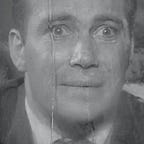Queertober Part 4: Poison
In the early 90s, as queer media by queer creators began to gain greater prominence, there was a movement called New Queer Cinema. What does and doesn’t belong to it is a complex and frankly very boring discussion, but the long and short is that there was a mini boom of queer movies made by queer artists in the early 90s. And much like the larger indie movie boom it was part of, one of the early entries was a scrappy little black and white microbudget film made by a director who would go on to be more famous.
Poison is an odd film, in more ways than one. For one thing, it’s not really a single film, it’s more 3 separate stories, that bounce off each other in weird ways. These stories aren’t connected in any real way, they don’t even exist in the same subgenres. The first of the stories is a pretty complex men in prison story, the second is a mockumentary about a boy who murdered his stepfather and then disappeared, and the third is a 50s sci-fi horror pastiche about a man who distills human sexuality down to an elixir and accidentally drinks it, becoming a leprosy spreading monster in the process.
Normally this would be the kind of thing I would dismiss, the product of a young and hungry filmmaker just throwing every idea they had at the wall to try and make an impression in what might be their only shot. Except in this case, the director in question is Todd Haynes. The man was only 4 years out from making Safe, only 9 from making Far From Heaven. The man is clearly a great director, and you can already see flashes of it in this movie, so I figure it deserves at least a little scrutiny.
And there is more in there, especially from a queer perspective. The story set in prison delves really heavily into the ways in which homoerotic desire can become violent and destructive under the weight of homophobia and toxic masculinity. The segment is shot with a surprising tenderness, with the object of the character’s desire framed in a way you rarely see men framed on film, but as it goes on and the weight of the expectations of their surrounding environment begin to weigh on them, it becomes darker and darker, culminating in some truly dark sequences. This is clearly the segment the film is built the most around, and probably the best of them.
The second story, the one about the scientist, is weaker (although it still looks great for its tiny budget) but I think I can find the throughline. If we take it as read that the film is about the destructive nature of desire (which, you know, it kind of literally is) then the throughline becomes fairly obvious, about how desire can become destructive, and the recurring bit where it’s spread simply by being around him certainly adds to that, but I dunno if the plot is as well developed as it needs to be to make sense. I feel like this is one area where the 50s throwback style is holding it back, but it’s an interesting concept.
As for the one about the kid killing his father, I dunno, I don’t get this one. There’s just a lot of elements and they don’t really blend; A running bit about his often disturbing relationship with his classmates never resolves, and while the plot hints at things like him being evil, the fact that he kills his father to save his mother and then…flies away? Ascends into heaven? I dunno, it muddies the ideas to the point where I can’t figure out what it’s trying to say. Of all three of the stories, this one would benefit the most from an expansion to feature length. At least then I might get enough pieces to try to connect the dots.
And I do want to connect the dots, because Todd Haynes is quite a filmmaker and there is a lot here. The emotions in the prisoner story are appealingly raw, in a way that I don’t know if a lot of filmmakers would be willing to do, and there’s even a lot of depth in the scientist plot, even if the 50s schtick muddles it a bit too much to come through clearly. The director who would go on to make Carol and I’m Not There is in here, he just hasn’t finished emerging from his cocoon.
You know, I made an implied reference to Clerks in the first paragraph, but at the risk of beating a very very dead horse, I don’t know if Kevin Smith would ever be willing to be this raw. There is something human and honest at the center of this film, and I don’t know if too many filmmakers, especially filmmakers in the 90s, would be willing to shed as many layers of irony as would be required to make a film like this.
But shedding layers of irony is definitely not a concern of our next film, because next time we’re talking a bit about queer desire between villain and hero, and also odd initial appraisals of queer films. We’re going 18 years in the future from this film to Jennifer’s Body.
